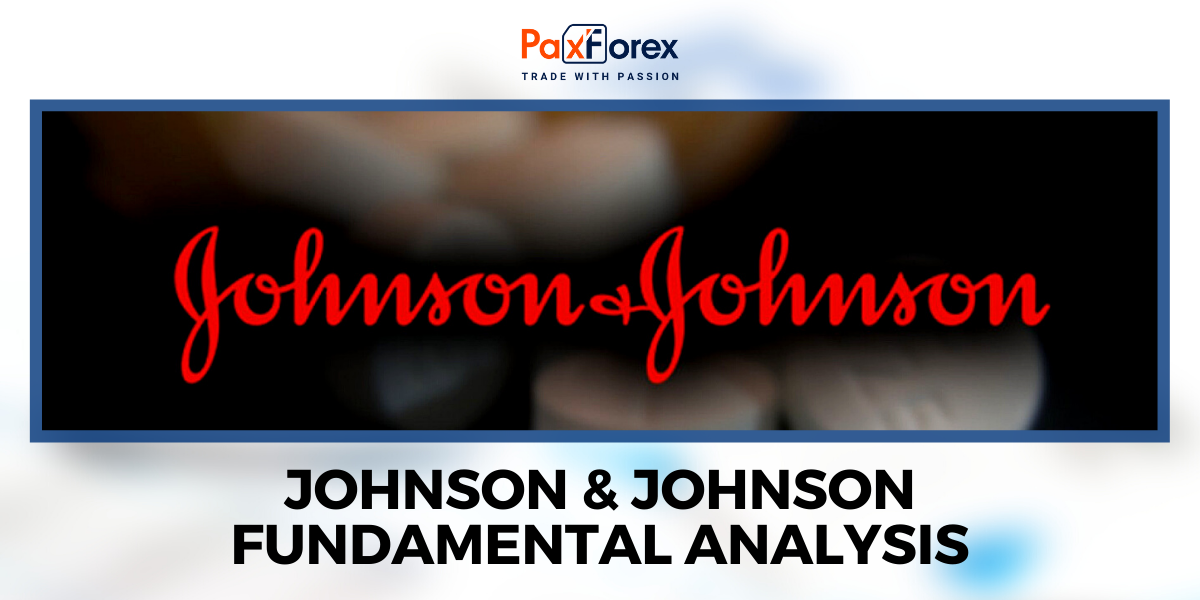
Source: PaxForex Premium Analytics Portal, Fundamental Insight
Johnson & Johnson is poised for significant changes in the coming years. Its flagship drug Stelara is set to face a patent cliff this year, the company has recently spun off one of its business units, and its legal issues remain unresolved, adding to the uncertainty.
Let's examine the potential opportunities and risks associated with the company and determine if it is a favorable time to include Johnson & Johnson shares in your investment portfolio.
Historically, one of the main drawbacks of investing in Johnson & Johnson has been its limited growth prospects. While it has maintained a solid reputation as a safe investment, it has struggled to generate substantial growth. Despite its diverse business segments encompassing consumer health, pharmaceuticals, and medical devices, its growth rate has been underwhelming.
With the spin-off of its consumer health division, Johnson & Johnson now has the opportunity to allocate more resources toward pursuing growth initiatives. In 2020, the company made a significant acquisition by purchasing Momenta Pharmaceuticals for $6.5 billion. Additionally, it acquired Abiomed, a heart pump maker, for a substantial price tag of $16.6 billion. It is likely that Johnson & Johnson will continue to seek out similar acquisitions in the next five years as part of its expansion and diversification strategy.
Even without considering mergers and acquisitions, Johnson & Johnson had previously projected that its pharmaceutical business alone could achieve $60 billion in sales by 2025, despite the anticipated loss of exclusivity for its top-selling product, Stelara. In the previous year, the company's pharmaceutical segment generated $52.6 billion in revenue.
If Johnson & Johnson is able to resolve its talc lawsuits successfully, which seems plausible given the positive response from plaintiffs' lawyers to the recent offer, the company will be in a better position to pursue acquisitions. This would result in reduced litigation costs and enable the company to allocate more funds toward strategic investments.
The talc lawsuits represent the most significant risk for the company, and their resolution could potentially empower Johnson & Johnson to adopt a more assertive approach to acquisitions. This, in turn, could significantly enhance the company's future growth prospects.
It appears highly likely that Johnson & Johnson will continue its streak of dividend growth, which spans 61 consecutive years. Considering the company's resilience throughout various challenges, including pandemics and recessions, it is difficult to imagine a scenario in which it breaks this streak.
However, the primary risk that could impact the dividend is related to the talc lawsuits. If the associated costs and legal obligations become uncontrollable to the extent of threatening the business, the dividend might be affected. Nevertheless, such a scenario would represent a particularly bleak outlook.
In all probability, Johnson & Johnson will maintain its dividend growth streak. The only question may be the rate of increase. The company could raise its dividend by a minimal amount, even as low as $0.01, to sustain the streak.
In terms of the recent dividend hike, Johnson & Johnson increased it by 5.3%, which is lower than the 6.6% hike from the previous year. If the company shifts its focus more towards growth, future dividend increases might be more modest.
Johnson & Johnson is generally regarded as a safe long-term investment for generating income. If your investment priorities revolve around safety and dividends, it is a compelling choice to consider, especially considering its proximity to its 52-week low.
However, if your focus is on growth, there are likely other stocks with faster growth potential to explore. Over the past decade, Johnson & Johnson's total return, including dividends, of 147% has significantly trailed behind the S&P 500's gain of 227%. I don't foresee this trend changing significantly in the next five years.
While Johnson & Johnson may continue to make acquisitions, it has yet to demonstrate a propensity for large-scale, game-changing deals. Such acquisitions would likely be necessary for it to become a more enticing option for growth-oriented investors.
Fundamentally, Johnson & Johnson has been perceived as a safe haven stock, and it's important for investors to acknowledge that choosing this investment may involve sacrificing some potential gains in exchange for long-term stability. If you are comfortable with this trade-off, it can serve as a solid healthcare stock to buy and hold.
As long as the price is above 160.00, follow the recommendations below:
- Time frame: D1
- Recommendation: long position
- Entry point: 163.96
- Take Profit 1: 166.00
- Take Profit 2: 170.50
Alternative scenario:
the level of 160.00 is broken-down, follow the recommendations below:
- Time frame: D1
- Recommendation: short position
- Entry point: 160.00
- Take Profit 1: 157.50
- Take-profit 2: 154.00













